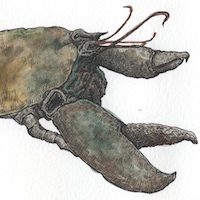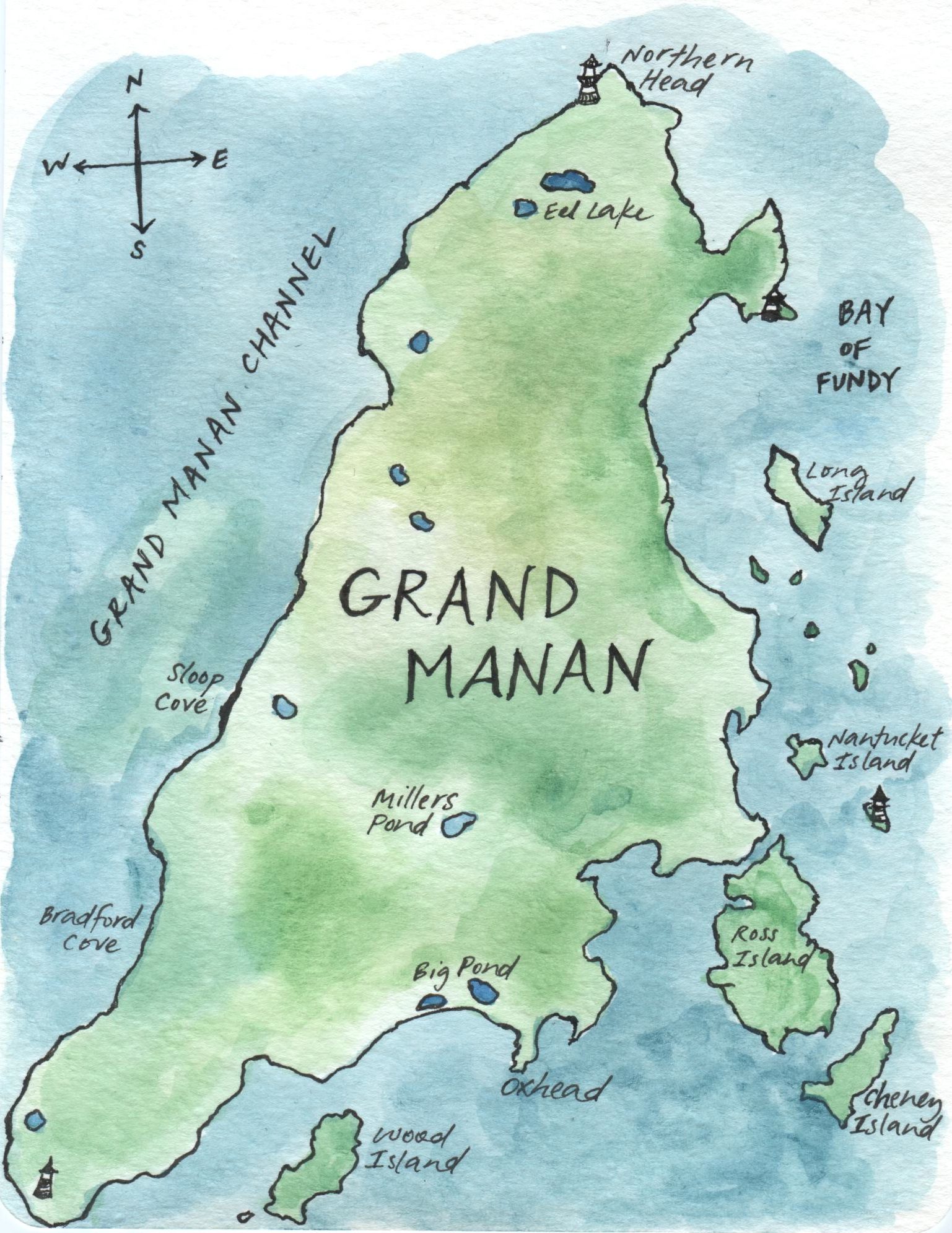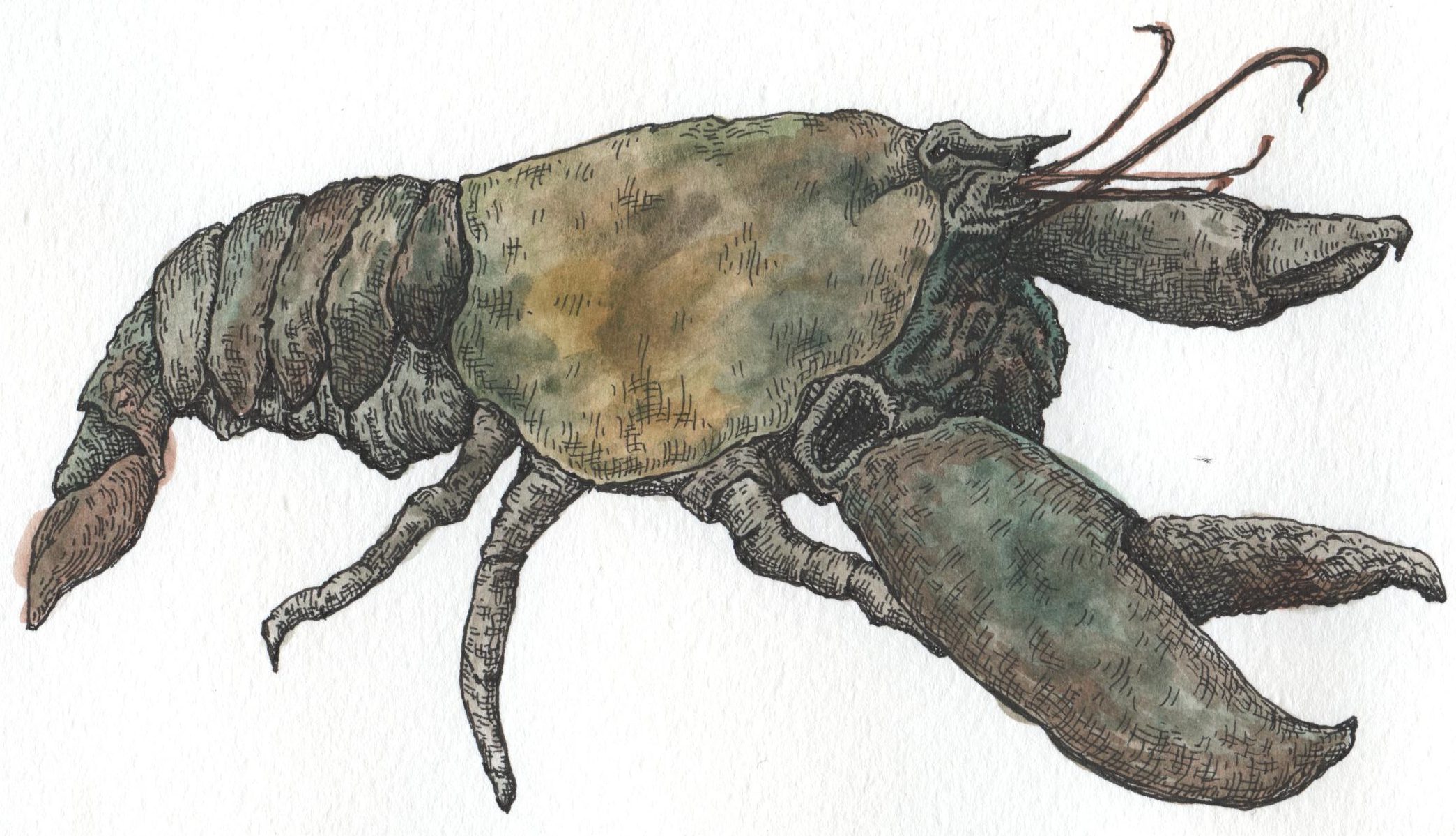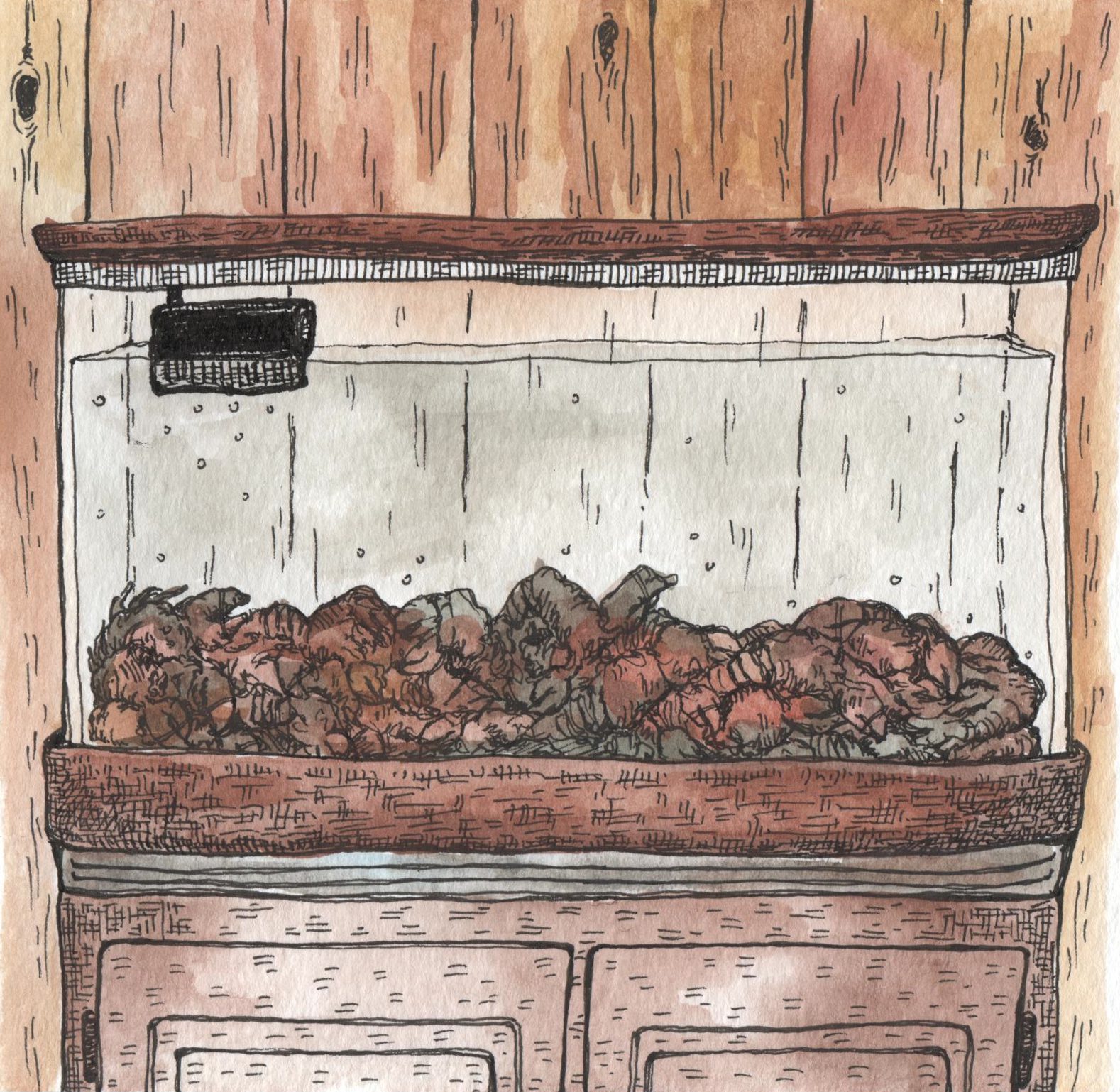
Every summer since 1956, I have returned to Grand Manan Island in the Bay of Fundy, where my parents bought a fisherman’s cottage that was built in 1864. The place is a bit derelict—cedar shingles covered with lichen, the fieldstone cellar sodden as a swamp, the old chimney covered with a plywood and fiberglass box to stop the creosote-stained leakage. The cottage has stood up pretty well, considering that it is neglected for most of the year. From my deck, I watch Swallowtail Lighthouse keeping its vigil, the ferry with its regular arrivals and departures setting the rhythm of the place, sea kayaks slicing past the bell buoy and along the glass-flat bay, a scow hauling a load of top stakes and twine as it heads out to a herring weir, lobster boats heading home from the salmon cages, the bay pinked with sunset.
I’m like the migratory right whales and arctic terns that keep this place on their annual map. They come here to breed. I come here to brood. I like the affinity between the two words. I have no intention of incubating young birds or nursing a young mammal, but there is something generative about thinking deeply, even thinking darkly, into things. On the island the thinking is often accomplished while I’m hiking along seaside cliffs in the woods or cutting back the hardhack and alders that threaten to overtake my small purchase on domestic life. The body in motion encourages thought. The more active I become, the more requited the thinking becomes. This can be problematic for a writer as I cannot go anywhere without carrying a notebook. If I lose a pen in the woods, I have to practice stringent techniques of mind control to keep the bounty of words from falling like dead leaves to the ground. I should master that palace-of-memory strategy used by the ancients, but it seems a bit too grandiose for my woodland meanderings. Maybe I could try using the island’s villages for a mnemonic: North Head standing for the first spark of inspiration, Castalia for settling into reverie, Woodwards Cove where the old fish houses perch for grounding the idea in the concrete, Grand Harbour where the great old sailing ships anchored for going into history, Seal Cove for including the lives of animals within the human story, and Southwest Head for standing on a precipice and gazing as far into the future as the mind’s eye can see.
Grand Harbour where the great old sailing ships anchored for going into history, Seal Cove for including the lives of animals within the human story, and Southwest Head for standing on a precipice and gazing as far into the future as the mind’s eye can see.
But last year I needed no mnemonic. My brother’s death was the urgency that called me. In August 2011, after two months of back pain, he’d received the diagnosis of small-cell cancer of the prostate that had metastasized to the spine. This is a very rare cancer—fewer than 1 percent of prostate cancers have this designation. It’s usually advanced at diagnosis, because it doesn’t show up on the routine prostate-specific antigen test. The median survival rate is ten months. My brother died seven months after the diagnosis and just shy of his sixty-seventh birthday. In the last two months of his life, I helped facilitate his care and finances, both of which had fallen into frightening disarray. The cancer had moved to his brain. He’d lost the ability even to operate a TV remote or a cell phone. He wasn’t sure about the name of his doctor or which of the fourteen or so meds he was supposed to take at what time. His wife was hysterical and long addicted to prescription pain medication.
He had lived hard, since adolescence finding in drugs a transcendence that drew him. I remember his excitement in 1965 when he first discovered weed. I remember the day, the moment, his joy. White kids from the suburbs did not smoke weed in those days. It was the era of Reefer Madness, an underground thing for the über and urban hip. He found his way from our pastoral town into the inner city—he was drawn to the outlaw mystique—where he scored. He was stoked with evangelical zeal right away, a conversion experience. Life had finally gotten real. Weed first and then dabbling in meth and horse, a long marriage to hallucinogens, and a gluttonous stretch of cocaine that led to dealing and doing time. Perhaps he had a problem, as the current addiction thinking suggests, with the neurochemistry of reward. Great hunger, little reward. Keep feeding the hunger, keep feeling the lack of reward. He would not have seen it this way. He saw himself as a spiritual seeker, a shaman living in Los Angeles, working construction and writing screenplays and adventuring in the far ranges of consciousness using pharmaceuticals as his guide. He saw himself as a hero, or at least a survivor, of the underground. It’s ironic that he died from a disease that requires a pharmaceutical dance of such complexity and ferocity that managing the meds becomes a full-time job.
My brother loved lobsters. Summers when the family drove up from Connecticut to Grand Manan, we stopped to visit friends of our parents who lived in West Gouldsboro, Maine. They took us onto Frenchman Bay in their speedboat. We beached near the base of Cadillac Mountain, clambering out onto the stony shore for a picnic supper. We smashed open the lobster shells with rocks, drenching ourselves with their juices and throwing the red calciferous remains into the sea. My brother had been a sullen and silent child. He resisted what my mother offered at home, which made him subject to routine hectoring about his failures at the dinner table. Under beach party rule of law, he dove into lobsters like a predator, smashing and ripping, sucking the juices out of each fat claw and skinny leg, plucking the sweet meat out of every crevice, and asking for more. Long after everyone had leaned back onto a boulder in satisfaction, he’d be smashing another crustacean open, juice running up his arms and down his chin, and picking out the white morsels of meat. “Do you want another lobster, Rodney?” the hosts would tease, after he’d begun to look like he’d had an overdose.
Lobsters are crustaceans. They wear their skeletons on the outside of their bodies like a crust and shed them as they grow. When they’re young and growing, they may shed ten times a year, later once every few years. A lobster is like a snake that outgrows its skin and must shed the sack shaped like its body to make room for the new one. After molting, a lobster is vulnerable to predators for a few weeks. After molting, a female emits a pheromone that makes males less aggressive and signals her readiness for mating. The couple enters into a closed-claw courtship dance. This is a good thing, because lobsters can be nasty and pugilistic. In captivity they can become cannibalistic. But they calm down for sex. The American lobster (Homarus americanus) loves the colder waters of the north, its range extending from North Carolina to Labrador. At least that has been the range for as long as people have been around to notice.
Lobsters have lived in the sea since the great age of dinosaurs. Where they have enjoyed their benthic lifestyle in the deep past is their own private matter. The oldest fossil lobster on record dates back to the early Cretaceous, the geologic period that began about one hundred fifty million years ago and ended sixty-five million years ago with the cataclysmic extinction that took down the dinosaurs. All during this period, lobsters were scuttling about the ocean floor on their ten legs and breaking open shellfish for supper. The breakup of Pangaea had begun. Flowering plants had begun—magnolia, ficus, and sassafras beginning to outnumber ferns, horsetails, and cycads. Whatever the lobsters have been doing, it has worked. Next to their species’ longevity, ours is negligible. They have been on Earth about six hundred times longer than we have.
Lobsters look like primitive greenish-brown hulks with gnarly and spined appendages, stalked eyeballs perched like goggles on the forehead, and bright-red antennae waving around like amateur periscopes. They live in the murky environment near the ocean floor, so the antennae help them to smell their way around. They can sense smells the way humans can sense sounds, knowing the direction from which the stimulus is coming. They use smells to communicate. Urine is the language they use to signal a rival or a mate: “I’m here.” That simple message is the basis of a great deal of Earth’s fragrance, rankness, music, and noise. Lobsters can shoot streams of urine six feet out in front of them from two bladders holstered on either side of their heads.
Lobster claws are asymmetrical. A lobster has a crusher claw with lumpy, rounded protrusions like a human molar, and a seizer claw (a.k.a. cutter or pincher) with serrated edges lined with sensory hairs and tiny sharp teeth. The crusher claw, which denotes the lobster’s handedness, has slow-twitch muscle fibers. It can sustain long and strong contractions. The seizer claw has fast-twitch muscle fibers for  rapidly snatching prey. Lobster blood is blue rather than red, because it uses copper rather than iron to carry oxygen through the body. In colonial times, lobsters were so bountiful in New England that they washed up on the beaches and were gathered in bushel baskets as food for servants and slaves. As late as 1800, according to Grand Manan historian L. K. Ingersoll, “lobsters were so plentiful in all the little bays and coves that almost anyone could go wading at low water and pick up enough for dinner. No great value was placed on the fish. . . . It was not uncommon for cartloads to be hauled on the fields for fertilizer, after storms had driven them up on the beaches in great windrows.”
rapidly snatching prey. Lobster blood is blue rather than red, because it uses copper rather than iron to carry oxygen through the body. In colonial times, lobsters were so bountiful in New England that they washed up on the beaches and were gathered in bushel baskets as food for servants and slaves. As late as 1800, according to Grand Manan historian L. K. Ingersoll, “lobsters were so plentiful in all the little bays and coves that almost anyone could go wading at low water and pick up enough for dinner. No great value was placed on the fish. . . . It was not uncommon for cartloads to be hauled on the fields for fertilizer, after storms had driven them up on the beaches in great windrows.”
The biggest lobster on record is a forty-four-pounder caught off Nova Scotia. It’s in The Guinness World Records. A lobster that size could be one hundred years old. Lobsters don’t seem to weaken or lose fertility with age. This has been tested out in labs. The enzyme telomerase just keeps repairing their DNA sequences. In theory, a lobster could live forever.
Lobsters figure prominently in Grand Manan’s history. It’s one of the fisheries that helped the culture thrive for the past two hundred years. Now that the groundfish—cod, haddock, and pollock—are diminished, lobsters are one of the last remaining sources of economic security for the island’s two thousand residents. This is a hardworking and pragmatic place. Yet it drifts now into the future. The island was long the smoked herring capital of the world. Ingersoll reports that in 1878 “a half million boxes [eighteen pounds each] of smoked herring were produced and sold for export to the West Indies market.” In 1880 a million boxes were processed and shipped. Herring were—and still are, to a lesser extent—caught in brush weirs constructed offshore, graceful structures that look more like art than work, stakes ringed around and set into the seabed, top stakes of birch saplings lashed to stakes and twine hung to form the seine. A herring weir is iconic of the place, a harmony between nature and culture inspired by the extreme tides of the bay.
Now herring are sparse. Dulse, a nutritious purple seaweed gathered for world markets, is diminishing as the ocean warms. Salmon aquaculture continues, but without the verve that came with the first wave of the industry. There are too many unknowns: how to minimize pollution of the bay, prevent the viral attacks of infectious salmon anemia, and prevent farmed stock from escaping and entering rivers like the Magaguadavic, where they interbreed with and weaken wild fish. Lobsters, however, are plentiful. Some islanders say that’s because the groundfish are gone, so the small lobsters have a better chance to survive. A biologist told me that warming waters to the south mean lobsters are moving north. Good news for the Bay of Fundy. Bad news for Massachusetts. For now. How long before the lobsters head for Labrador?
After my brother died, it was a comfort to be alone at the family cottage, a good place for grieving and contemplation. As a refuge, the island was that summer, as it always had been, a place of beauty, rugged tranquility, and simple living. For one week, I was flattened by grief: sleep, read, nap, work. Only manual work satisfied: plaster the walls, clear the trail, haul junk to the dump, air out musty pillows and blankets in the sea breeze. The waves some nights were loud as they thrummed the rocky shore just like the cadences of grief that came in waves.
My neighbor came one day to fell three dead spruce trees—the latest victims of the woodland beetle depredation on the island. When the trees started dying, my neighbors consoled me: “Oh, Alison, it’s just their time.” But after dozens went, after whole hillsides began to look like their green hair had turned gray, it became clear that this was not ruin on the expected time scale of arboreal aging and decline. Woodland parasites are doing well in many forests, with warmed winters allowing more larvae to make it through the cold, parasites emerging in the spring and feasting through the bark.
Over the past two or three years, I’ve lost thirty or forty black spruces and tamaracks. Some were wider than I could compass with my arms, grand elders I’d admired, because on a working island where the forest has been used for two centuries for ship’s masts and weir stakes and house timbers, a tree that old is one you tend to notice. There was a spruce in front of my writing studio with an uncanny curving trunk, as if it had had to weave its way past fallen limbs as it climbed. The obstacles were long gone, but the waves in the wood remained.
When the trees were cut, the chain saw stopped roaring and there was silence. Then the trunk cracked at the juncture where the wood had its last grip on the vertical. It was strangely beautiful to watch the old giants lean, hold, lean, and then go. Released. They landed in a muffled whoosh, dry branches cushioning the fall.
The birds kept me company, singing from what was left of the woods. On the day the last three spruces fell, the forest went crazy with cowbirds screaming about the disruption. By the next day they were gone. I wanted to be like them—adjusting to loss, letting my complaint rip, then moving on. Or like the forest ground that wastes not a minute contemplating ruin: here thirty tiny spruces sprout, here a sprawl of wild raspberries leap, here the yellowthroats call back and forth across the opening—all beings embracing the new exposure to sun.
Grief can flatten you. What is its purpose? At a gathering of writers that spring convened by Orion magazine to discuss the theme of loss and resilience, Carolyn Finney said that many people feel no grief. She asked, “Does it make sense to think about grief and loss?” John Elder said, “Grief is about liberation—not being stuck and moving forward.” Kathleen Dean Moore said, “Love is a necessary condition for grief. Grief is a necessary condition for love.” Rubén Martinez said that grief’s renunciation and withdrawal to “the desert” forces us into interior process and moral awakening. Sandra Steingraber said, “one in four mammals” . . . “coral reefs” . . . “tipping points” . . . “reinforcing feedback loops.” A dissident said, “Grief? What good is it?” Julia Witty said, “Grief is a natural state. Knowledge of the ephemeral. We are undefended in grief. A new world within is being constructed.” Someone said, “It helps to have a ritual.”
I liberated a lobster into the Bay of Fundy in honor of my brother. He loved lobster and he loved the Bay of Fundy. I bought the pound-and-a-quarter lobster at the Fundy House, the local takeout and ice cream place.  A few dozen lobsters were all jammed together in the fish tank, lying in a semitorpid heap. “Just one?” the proprietor asked. “Just one.” She was kind enough to give me a restaurant-sized Heinz ketchup can to carry it in. I did not tell her what I wanted the lobster for. What was the point?
A few dozen lobsters were all jammed together in the fish tank, lying in a semitorpid heap. “Just one?” the proprietor asked. “Just one.” She was kind enough to give me a restaurant-sized Heinz ketchup can to carry it in. I did not tell her what I wanted the lobster for. What was the point?
I’d never been on the island that late in the fall. The blackberry leaves had turned crimson, the alders a pillow of gold on the steep shore leading from the cottage to the stony beach. The white birches had gone bare. The apple trees held onto their last fruits of the season even as the leaves blew away. The sky hung low with steely clouds. Rain squalls came in and blew out. The tide was low. I walked across the gauntlet of rockweed-covered boulders to get to the tide pools, slipping and sliding, a lobster in one hand, scissors in the other. When I got to the water’s edge, I turned around to watch the last of the conflagration on the beach. I’d lit a fire in the Heinz can—my brother’s death certificate, the official seal of California with its conquistadors and “Eureka” motto, going up in smoke, along with a few strips of cedar wainscoting left over from the job he’d done at the cottage a few years back on a rare visit to the island.
I snipped the rubber bands from the lobster’s claws and set it in the icy tidepool.
What happened then is not at all what I expected. I’d thought of doves set free at a wedding, bursting forth into exuberant freedom. I’d thought the lobster would sense freedom and swim (yes, I thought it would swim) for the depths. Wouldn’t it be coded to hightail it for the benthic zone? “May you travel well into the vastness,” I said. A small bit of theater in the face of the eternity of water stretching out as far as I could see. The lobster, of course, had no use for my exhortation. And what could I know of my brother’s spirit, which had become even more inscrutable with his death?
Lobsters walk, I later learned. Or they swim backward by curling and uncurling their abdomen. And young lobsters, like my little rescue, live in burrows or crevices within ten feet or so of the shore. This lobster knew just what to do. Backing its way into a nook between two boulders, it dug out a burrow with its swimmerets, scooping and plowing, sometimes head first, sometimes tail. Periwinkles kept losing their suction and popping off the rocks to fall into the water at low tide, their percussion sounding like slow castanets. A few long-clawed hermit crabs scuttled their homes along on walking legs. Some creature that looked like a tiny black softball with a tail darted around in the crystalline water of the tide pool. I gathered up a few periwinkles and tossed them in front of the lobster as it lay nestled in its keep. It didn’t budge. I felt silly and satisfied, a little levity rising as my expectation for transcendence gave way to biology. No, I thought, this is it. What grief demanded all along was trust in the learning embedded in every organism. I could see the grounds for that trust in the dignity with which my brother met his end.
“I don’t know what happens next,” my brother had worried.
“No one does,” I said. “You’ve hungered for the spirit world all of your life and now it’s very close.”
“Yes,” he said. “I’ve seen glimpses of it and it was very beautiful.”
“Hold onto that. It means your body knows how to do this.”
I could see the grounds for that trust in the sureness with which the liberated lobster dug itself a home. Maybe instinct is a measure of the spiritual life of animals, something they can’t control that drives them to their fate, something insubstantial that becomes as real as solid things.
***
Rumpus original art by Claire Stringer.
***
“Liberating the Lobster” is from Zoologies: On Animals and the Human Spirit by Alison Hawthorne Deming (Minneapolis: Milkweed Editions, 2014). Copyright © 2014 by Alison Hawthorne Deming. Reprinted with permission from Milkweed Editions.




